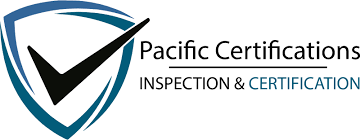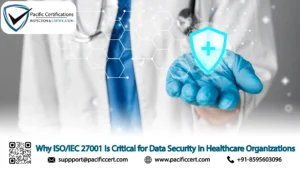
Big tech now runs on trust. Cloud platforms, AI products and data-driven services sit at the centre of global trade and daily life, which means the stakes around security and responsible AI are higher than ever. Breaches can erase years of reputation in a night and ungoverned AI can trigger legal risk and public backlash. That’s why leading tech institutions are moving fast on ISO/IEC 27001 for information security and ISO/IEC 42001 for AI management. Together, these certifications help protect data, govern AI and give buyers proof that controls are in place and audited.
Schedule a 15-minute call with an auditor at Pacific Certifications to map your certification pathway!
Quick summary
“Top tech institutions prioritize ISO/IEC 27001 to safeguard data across clouds, devices and global teams and ISO/IEC 42001 to govern AI ethics, transparency and risk. The pair provides end-to-end assurance for digital services by linking security controls with AI oversight, backed by KPIs like incident resolution time, model review cadence, bias test coverage, audit closure time and SLA uptime commitments.“
Introduction
Security and AI governance now shape customer decisions, regulator scrutiny and enterprise contracts. ISO/IEC 27001 sets a tested framework for protecting information, while ISO/IEC 42001 introduces a formal AI management system focused on fairness, accountability and lifecycle control. Adopting both signals that an institution treats data and AI as managed systems, not ad hoc features, which shortens due diligence in sales cycles and opens doors to regulated markets.
Why 27001 and 42001 are rising together in tech?
Enterprise buyers rarely separate security from AI risk. A platform that protects data but lacks AI governance looks incomplete and an AI product without strong security is a liability. ISO/IEC 27001 answers the buyer’s core security checklist: access control, encryption, change management, incident response, while ISO/IEC 42001 covers AI policy, risk assessment, data lineage, model testing, monitoring and human oversight. Used together, they reduce procurement friction, support privacy and AI laws and create a consistent story for trust across products and regions.
What are the requirements for ISO/IEC 27001 and ISO/IEC 42001?
Tech institutions need structured systems that connect policy, risk and day-to-day controls. Key requirements include:

- Define the scope for security and AI governance across products, services and locations.
- Publish institutional policies for information security, AI ethics, transparency and accountability.
- Conduct risk assessments covering threats like data breaches, insider risk, AI bias and misuse.
- Document processes for access control, change management, data lineage, model validation and monitoring.
- Provide evidence records such as vulnerability logs, incident tickets, model cards, bias test results and audit trails.
- Train teams on secure engineering, secure AI and role-based responsibilities.
- Implement operational controls including encryption, key management, SSO, bias detection, explainability checks and guardrails.
- Carry out internal audits for both security and AI lifecycle controls.
- Leadership reviews of objectives, risks and performance indicators.
- Address nonconformities with corrective actions and track closure.
- Commit to continual improvement as threats, models and regulations evolve.
How to prepare for 27001 and 42001 together?
- Run a dual gap analysis mapping current controls to both standards.
- Align policies so security and AI governance use shared definitions, roles and escalation paths.
- Train product, data and ML teams on control requirements and audit evidence.
- Build documentation for data flows, model cards, threat models and runbooks.
- Implement controls that satisfy both standards, for example secure data pipelines with lineage, approval gates and rollback.
- Pilot internal audits on a flagship product before scaling.
- Engage leadership to fund remediation, set KPIs and approve scope.
Certification audit
Stage 1 audit: Reviews documented policies, scopes, risk assessments and evidence for security and AI governance.
Stage 2 audit: Evaluates implementation across code repos, data pipelines, model ops and production environments.
Nonconformities: Must be corrected with documented evidence before certification approval.
Management review: Confirms leadership oversight and resources for ongoing security and AI controls.
Final certification: Awarded after all compliance gaps are resolved.
Surveillance audits: Conducted annually to verify controls remain in place and effective.
Recertification audits: Required every three years to maintain market validity.
What are the benefits for tech institutions?
Adopting 27001 and 42001 together reduces sales friction, supports privacy and AI rules and builds trust with enterprises that demand both security and responsible AI. Institutions track progress with KPIs such as mean time to detect and respond, critical vulnerability closure time, model drift alerts, bias issue rate and SLA uptime. The main benefits include:

- Buyer confidence in security and AI governance during procurement
- Access to regulated markets with lower due-diligence burden
- Lower risk of breaches, misuse and governance failures
- Clear accountability across product, data and ML teams
- Faster sales cycles due to standardized evidence and certifications
- Better incident readiness with tested runbooks and audit trails
Recent trends in 2025
Top tech institutions are building integrated management systems that merge ISO/IEC 27001 and ISO/IEC 42001 with ISO 9001 and ISO 22301 to reduce duplication and keep one control library. AI supply chains are a focus area, with vendor SLAs now covering data access, model updates, explainability reports and security posture. Teams publish dashboards for KPIs such as incident resolution time, bias testing frequency, model rollback rate and audit closure time so customers see progress, not just a certificate.
Contact us
Pacific Certifications certifies ISO/IEC 27001 and ISO/IEC 42001 for leading tech institutions. We help you map scope, close gaps and prepare evidence that satisfies enterprise buyers and regulators.
Request your ISO audit plan and fee estimate, we will help you map Stage-1/Stage-2 timelines and evidence requirements for your institution. Contact us at support@pacificcert.com or visit www.pacificcert.com.
FAQs
- Why are tech institutions pairing 27001 with 42001?
Because buyers want assurance on both data security and responsible AI in a single procurement cycle.
- Can startups adopt these standards?
Yes, both are scalable. Start with a narrow scope and expand as products grow.
- How long does it take to certify?
Most institutions complete certification in 6 to 12 months, depending on scope and readiness.
- Do these standards overlap?
Yes. Risk assessment, training, internal audits and management review align well, which cuts duplication.
- What evidence do auditors expect for AI governance?
Policies, risk registers, data lineage, model cards, bias tests, approval gates, monitoring and incident logs.
- What KPIs matter most to buyers?
MTTR for incidents, critical vuln closure time, uptime, bias issue rate and audit closure time.
- How do SLAs connect to certification?
SLAs turn controls into customer commitments, for example uptime or model review cadence.
- Will certification cover privacy laws like GDPR?
It helps align controls and evidence, but you must still meet each law’s specific requirements.
- What are common gaps during audits?
Unclear scope boundaries, missing data lineage, weak access reviews and limited bias testing.
- How should we structure scope across products?
Start with high-risk or flagship products, include shared platforms and data pipelines, then extend to the portfolio.
Ready to get ISO certified?
Contact Pacific Certifications to begin your certification journey today!
Suggested Certifications –
Read more: Pacific Blogs

Author: Alina Ansari





